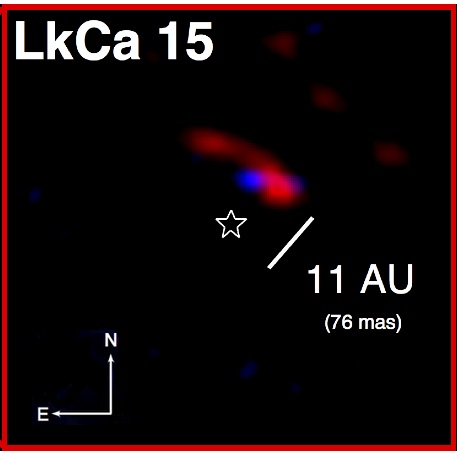Title: LkCa 15: A Young Exoplanet Caught at Formation?
Authors: Adam Kraus and Michael Ireland
Author’s Institutions: University of Hawaii and Macquarie University (Australia)
Finding the Youngest Planets: Imaging Planets as They Form
By directly imaging planets at the very early stages of planet formation, astronomers can better understand the planet formation process. There are two “competing” mechanisms formulated over the past decades as mechanisms to form giant planets. One is the theory that planets form by initially accreting cores of heavy elements and, after reaching a critical point, accreting a gaseous envelope through runaway accretion. The other theory suggests that early in the lifetime of a disk, the disk will fragment via gravitational instability and form planets. Each of these would leave observable signatures in the planets formed, which would be especially obvious for the youngest planets. Notably, planets forming via gravitational instability start with a high initial internal entropy and thus form with hot initial temperatures; in contrast, core accretion happens over a longer time period in a less violent way, and would form planets with cooler initial temperatures.
Finding Planets in Transition Disks

This shows an image of the LkCa Transition Disk at 850 microns. Note that there is a noticeable gap in the disk in the inner 50 AU from the center of the system.
Kraus and Ireland aim to observe very young planets right as they are forming to try and constrain which planet formation mechanism seems to be correct for planets we observe. They do this by observing the interior regions of systems with transitional disks. Transitional disks are disks around young stars that appear to have gaps when we look at their spectral energy distribution (see this astrobite for a great overview of protoplanetary disks). These gaps are postulated to form when a giant planet forming has ‘cleared out’ a region of the disk around its orbit. If we observe transitional disks in young star forming regions, if a bright young planet is indeed causing this gap, we expect to be able to observe the planet.
Non-redundant Mask Interferometry
However, imaging these planets is incredibly observationally challenging. Planets are both very close on the sky and many orders of magnitude dimmer than their host stars. (see this astrobite for another solution to this problem!). The authors employ a technique called non-redundant mask interferometry to achieve the full diffraction limit of the Keck 10-meter telescope. Essentially, the idea is to use a mask with a series of holes on it to block most of the light from the target. Instead of imaging the target as we would expect, the camera images the interferometric fringes of the target through this set of smaller sub-apertures. This technique only works for the very brightest targets because you lose so much light by using the mask.
By comparing the interferometric fringes of the target with a series of comparison stars (assumed to be point sources), the authors can reconstruct an image of the planet by analyzing how the target system differs from normal point sources.
The Youngest Directly Imaged Planet?

This figure shows the reconstructed image in L (red) and K (blue) bands of the purported protoplanet and surrounding region.
The authors present results that show a feature in the final reconstructed image in both K band and L band (2 bands in the near-infrared). The L band image is somewhat elongated and appears to include two separate regions. The K band image falls between these two L band regions and is more like a point source. The authors interpret this as a protoplanet in the process of forming with an extended heated region around it.
They compare this image to the luminosities we predict from both the core accretion and gravitational instability models and determine that it is too luminous to fit a planet made solely by core accretion. However, the planet, since it is a protoplanet in the process of forming, will have additional luminosity from the accretion process of forming a planet. This is not included in the models they compare to, so the authors are only able to make an approximate upper bound of about ~6 Jupiter masses for the mass of the planet.
This object is the first of a small survey of planets in transition disks that Kraus and Ireland are imaging with this interferometric technique. It is very interesting to observe these planets in the process of forming, but current observations and models do not actually allow us to constrain the formation mechanism of this system or exoplanets in general. We’ll have to stay tuned for more of these observations in the years to come!

Trackbacks/Pingbacks